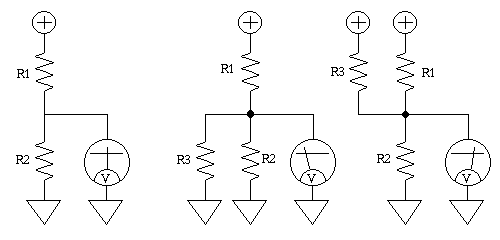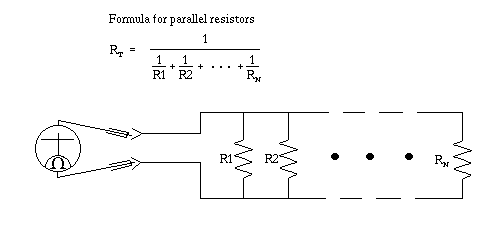

Total equivalent resistance of simple series resistors is simply the numerical
sum of all the individual resistors from one end of the power source through
the circuit to the other end of the power source.
In left hand circuit, of the top picture, I show such a simple series resistor
circuit. To get the numerical value of the total series resistance placed
across the power supply, in this case from (+) to GND one simply adds up all
the resistor ohmic values. This is a simple example, there are two resistors
R1, and R2. If they were each 1000 ohms, the total would be 2000 ohms.
Knowing the total and the power supply voltage voltage, the current can be
calculated. If the voltage were 10 volts, 10 divided by 2000 is .005 ampere
or 5 milliampere, abbreviated as 5ma
In center circuit, of the top picture, the simple sum the resistance, and
divide the voltage by the total is complicated by the fact that the bottom leg
has two resistors in parallel. To make the calculation we now need some way
of combining the two parallel resistors, to make them appear to be one, at
least as far as our calculations are concerned. If R2, and R3 are each
1000 ohms, there total parallel resistance is 500 ohms. If you apply the
formula in the bottom picture, for calculating you should arrive at this
number.
Here's a Lab assignment, Acquire an inexpensive Volt/Ohm/Milliameter, often
called a multi meter. This is not meant to be an endorsement, but
Radio-Shack puts on sale about once or twice a year, for a smidgen less
than $25.00 US a 43 range Multimeter. This is not a fancy electronic one,
but rather is an electro-mechanical device, that has an analog, eg. pointer
sweeping across a scale, as opposed to a digital meter. While you're there
you should get a good assortment of resistors, whose values are in the range
of 10 ohms to 10 meg (million) ohms. If you're planning to buy components
for future elements of this course, consider an inexpensive power supply
such as a wall wart, you probably have one of these laying in a drawer
around the house. A 9 volt DC, one is preferred, but other voltages will
work. A nice large low voltage Electrolytic Capacitor is useful, say...
10,000 uf (microfarad) rated to withstand 20 volts or more. Don't spend
a lot on any of this stuff, most of can be obtained at a fraction of the
cost at Electronic Surplus stores, or through Surplus Catalog outfits.
Once you have a multimeter, and some resistors in hand, read the owners
manual for your meter, and select several resistors that are within
a ten to one ratio, Highest value, to lowest value. I haven't taught you
how to read the color bands yet, so use your meter to determine their
ohmic value. Try wiring them in various series, parallel, and series-parallel
circuits, try to predict the total resistance, using the formulas, and
a pocket calculator, and see if they agree with your predicted resistance
when you actually wire them up and make measurements with your multimeter.
Back to Learn Electronics Next